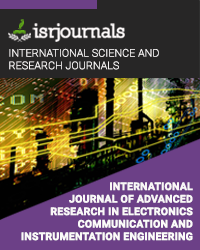detection and classification of alzheimers disease using deep learning
Akash Vijayan IV,Ashwin Joshua.N,Harikrishnan N,S.Ranjith, M.TECH.
Published in International Journal of Advanced Research in Electronics, Communication & Instrumentation Engineering and Development
ISSN: 2347 -7210 Impact Factor:1.9 Volume:3 Issue:1 Year: 05 April,2021 Pages:515-526

Abstract
In recent years, the diagnosis of Alzheimer’s disease (AD) has become one of the most challenging problems in medical fields. This paper proposes a new segmentation method which is used region masking for selecting the useful properties of affected parts in the human brain for improving the accuracy of diagnosis for AD. In the proposed method, the accuracy of classification is improved by using deep learning Network classifier, are selected by using region masking. Furthermore, the Convolutional Neural Network classifier is used for the diagnosis of AD. The data set will be discussed in this paper contains normal and AD subjects. The empirical results show that the proposed method significantly improves the accuracy of the diagnosis of AD in comparison with previous methods. Here, we briefly review some of the important literature on AD and explore how Deep Learning can help researchers diagnose the disease at its early stages.
Kewords
Alzheimer disease, Region Masking, Segmentation, Convolutional Neural Network, Deep Learning
Reference
1. Aguilar et al.C., “Different multivariate techniques for automated classification of MRI data in Alzheimer’s disease and mild cognitive impairment,” Psychiatry Res. - Neuroimaging, vol. 212, no. 2, pp. 89–98. 2. Conjeti et al., “Supervised domain adaptation of decision forests: Transfer of models trained in vitro for in vivo intravascular ultrasound tissue characterization,” Med. Image Anal., vol. 32, pp. 1–17. 3. Chen .X, Zhang .H, Gao .Y, Wee .C.Y. , Li .G, and Shen .D, “High-order resting-state functional connectivity network for MCI classification,” Hum. Brain Mapp., vol. 37, no. 9, pp. 3282–3296. 4. Gopalan .R, Li. R, and Chellappa .R, “Unsupervised adaptation across domain shifts by generating intermediate data representations,” IEEE Trans. Pattern Anal. Mach. Intell., vol. 36, no. 11, pp. 2288–2302. 5. Haller .S et al., “Individual classification of mild cognitive impairment subtypes by support vector machine analysis of white matter DTI,” Am. J. Neuroradiol., vol. 34, no. 2, pp. 283–291.. 6. Lee .W, Park .B, and Han .K, “Classification of diffusion tensor images for the early detection of Alzheimer’s disease,” Comput. Biol. Med., vol. 43, no. 10, pp. 1313–1320. 7. Ortiz .A, Górriz J. M., Ramírez .J, Martínez-Murcia F.J., and A. D. N. Initiative, “LVQ- SVM based CAD tool applied to structural MRI for the diagnosis of the Alzheimer’s disease,” Pattern Recognit. Lett., vol. 34, no. 14, pp. 1725–1733. 8. Sanz-Arigita E.J. et al., “Loss of ‘Small-World’ Networks in Alzheimer’s Disease: Graph Analysis of fMRI Resting-State Functional Connectivity,” PLoS One, vol. 5, no. 11... 9. Yan C.G., Craddock .R.C., Zuo X.N., Zang Y.F., and Milham M.P., “Standardizing the intrinsic brain: Towards robust measurement of inter-individual variation in 1000 functional connectomes,” Neuroimage, vol. 80, pp. 246–262 10. Zhao .X et al., “Disrupted small-world brain networks in moderate Alzheimer’s disease: A resting-state fMRI study,” PLoS One, vol. 7, no. 3.

